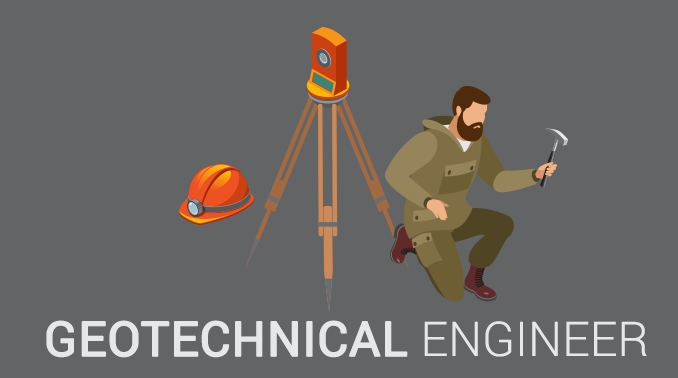Some Known Details About Geotheta
Some Known Details About Geotheta
Blog Article
All about Geotheta
Table of ContentsThe Facts About Geotheta UncoveredThings about GeothetaThe Buzz on GeothetaThings about GeothetaGeotheta - The Facts

They conduct site examinations, gather samples, do research laboratory examinations, and examine data to examine the suitability of the ground for building and construction jobs - Geo Tech Engineer. Based on their findings, geotechnical designers provide referrals for foundation layout, slope stability, maintaining frameworks, and mitigation of geotechnical hazards. They team up with other professionals, such as designers, structural engineers, and construction teams, to make certain that geotechnical factors to consider are integrated into the total project style and implementation
By evaluating the habits and properties of dirt and rock, they can recognize potential geotechnical dangers such as landslides, soil settlement, or incline instability. Their competence helps prevent failures or accidents that can jeopardize lives and building. Below are some thorough responsibilities and responsibilities of a geotechnical designer: Website Investigation: Geotechnical engineers conduct site examinations to collect data on subsurface problems.
They interpret the data to comprehend the properties and actions of the soil and rock, including their strength, permeability, compaction attributes, and groundwater problems. Geotechnical Analysis and Layout: Geotechnical engineers evaluate the data gathered throughout website investigations to analyze the stability and viability of the website for construction projects. They carry out geotechnical calculations and modeling to review variables such as birthing capacity, settlement, slope security, side planet stress, and groundwater flow.
Geotheta for Dummies
Foundation Layout: Geotechnical designers play a crucial function in developing foundations that can safely support the designated framework. They examine the dirt conditions and lots needs to establish the proper structure kind, such as shallow foundations (e.g., grounds), deep structures (e.g (https://www.behance.net/ianhammond2)., piles), or specialized strategies like dirt improvement. They take into consideration variables such as negotiation limits, birthing capability, and soil-structure communication to develop optimum structure styles
They review construction strategies, monitor site activities, and perform field examinations to validate that the style referrals are followed. If unexpected geotechnical problems arise, they assess the situation and provide suggestions for removal or adjustments to the design. Risk Assessment and Reduction: Geotechnical engineers analyze geotechnical hazards and threats connected with the task website, such as landslides, liquefaction, or dirt erosion.

Collaboration and Interaction: Geotechnical designers work carefully with various other specialists entailed in a task, such as engineers, structural engineers, and construction groups. Effective interaction and collaboration are important to incorporate geotechnical considerations right into the overall task design and construction procedure. Geotechnical engineers provide technological know-how, response questions, and ensure that geotechnical demands are satisfied.
Things about Geotheta
Here are some types of geotechnical engineers: Structure Engineer: Structure designers focus on developing and examining structures for frameworks. They examine the dirt conditions, tons needs, and site qualities to determine one of the most appropriate foundation kind and layout, such as shallow structures, deep foundations, or specialized methods like stack structures.
They i was reading this assess the aspects influencing slope security, such as soil residential properties, groundwater problems, and incline geometry, and develop strategies to protect against slope failings and reduce threats. Quake Engineer: Quake engineers concentrate on analyzing and designing structures to withstand seismic forces. They analyze the seismic hazard of a website, review dirt liquefaction possibility, and establish seismic layout criteria to make sure the security and durability of structures throughout quakes.
They carry out area screening, accumulate samples, and assess the collected data to define the soil homes, geologic developments, and groundwater conditions at a website. Geotechnical Instrumentation Designer: Geotechnical instrumentation designers focus on surveillance and determining the actions of dirt, rock, and frameworks. They install and preserve instrumentation systems that monitor variables such as soil settlement, groundwater levels, slope motions, and structural variations to evaluate efficiency and offer very early warnings of prospective problems.
7 Easy Facts About Geotheta Explained
They conduct examinations such as triaxial examinations, consolidation tests, direct shear tests, and permeability examinations to collect information for geotechnical analysis and style. Geosynthetics Designer: Geosynthetics engineers specialize in the layout and application of geosynthetic materials, such as geotextiles, geogrids, and geomembranes. They make use of these products to improve soil security, enhance slopes, offer drainage options, and control disintegration.
They often tend to be investigatory people, which implies they're intellectual, introspective, and investigative. They wonder, methodical, logical, analytical, and sensible. A few of them are likewise social, meaning they're kind, charitable, participating, patient, caring, useful, empathetic, sensible, and friendly. Does this noise like you? Take our complimentary job test to learn if geotechnical designer is just one of your leading occupation matches.
In the workplace setting, geotechnical designers utilize specialized software devices to carry out computations, create styles, and analyze data. They prepare reports, evaluation project specs, connect with clients and employee, and coordinate project activities. The office setup provides a conducive atmosphere for research study, evaluation, and cooperation with various other experts associated with the project.
The Ultimate Guide To Geotheta
They often go to job sites to conduct website examinations, analyze geotechnical problems, and gather data for evaluation. These check outs entail taking a trip to various places, in some cases in remote or challenging terrains. Geotechnical engineers might perform soil sampling, conduct tests, and monitor construction activities to make certain that the geotechnical aspects of the job are being carried out appropriately.
Geotechnical engineers likewise work in specialized geotechnical research laboratories. In these centers, they conduct experiments, do examinations on soil and rock examples, and analyze the engineering homes of the materials. Geotechnical research laboratory designers function extensively in these settings, handling testing devices, running tools, and recording data. They collaborate with other laboratory staff to guarantee precise and trustworthy testing results.
Report this page